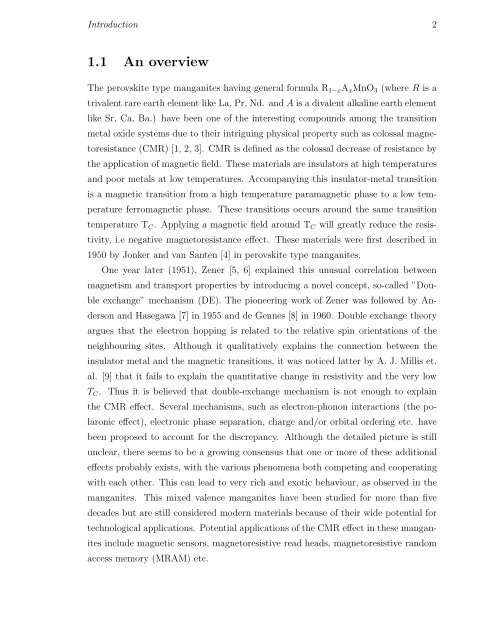PHYS07200604007 Manas Kumar Dala - Homi Bhabha National ...
PHYS07200604007 Manas Kumar Dala - Homi Bhabha National ...
PHYS07200604007 Manas Kumar Dala - Homi Bhabha National ...
Create successful ePaper yourself
Turn your PDF publications into a flip-book with our unique Google optimized e-Paper software.
Introduction 2<br />
1.1 An overview<br />
The perovskite type manganites having general formula R 1−x A x MnO 3 (where R is a<br />
trivalent rare earth element like La, Pr, Nd. and A is a divalent alkaline earth element<br />
like Sr, Ca, Ba.) have been one of the interesting compounds among the transition<br />
metal oxide systems due to their intriguing physical property such as colossal magnetoresistance<br />
(CMR) [1, 2, 3]. CMR is defined as the colossal decrease of resistance by<br />
the application of magnetic field. These materials are insulators at high temperatures<br />
and poor metals at low temperatures. Accompanying this insulator-metal transition<br />
is a magnetic transition from a high temperature paramagnetic phase to a low temperature<br />
ferromagnetic phase. These transitions occurs around the same transition<br />
temperature T C . Applying a magnetic field around T C will greatly reduce the resistivity,<br />
i.e negative magnetoresistance effect. These materials were first described in<br />
1950 by Jonker and van Santen [4] in perovskite type manganites.<br />
One year later (1951), Zener [5, 6] explained this unusual correlation between<br />
magnetism and transport properties by introducing a novel concept, so-called ”Double<br />
exchange” mechanism (DE). The pioneering work of Zener was followed by Anderson<br />
and Hasegawa [7] in 1955 and de Gennes [8] in 1960. Double exchange theory<br />
argues that the electron hopping is related to the relative spin orientations of the<br />
neighbouring sites. Although it qualitatively explains the connection between the<br />
insulator metal and the magnetic transitions, it was noticed latter by A. J. Millis et.<br />
al. [9] that it fails to explain the quantitative change in resistivity and the very low<br />
T C . Thus it is believed that double-exchange mechanism is not enough to explain<br />
the CMR effect. Several mechanisms, such as electron-phonon interactions (the polaronic<br />
effect), electronic phase separation, charge and/or orbital ordering etc. have<br />
been proposed to account for the discrepancy. Although the detailed picture is still<br />
unclear, there seems to be a growing consensus that one or more of these additional<br />
effects probably exists, with the various phenomena both competing and cooperating<br />
with each other. This can lead to very rich and exotic behaviour, as observed in the<br />
manganites. This mixed valence manganites have been studied for more than five<br />
decades but are still considered modern materials because of their wide potential for<br />
technological applications. Potential applications of the CMR effect in these manganites<br />
include magnetic sensors, magnetoresistive read heads, magnetoresistive random<br />
access memory (MRAM) etc.
















